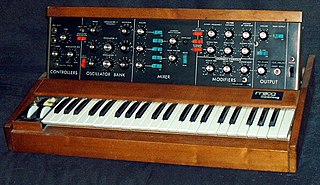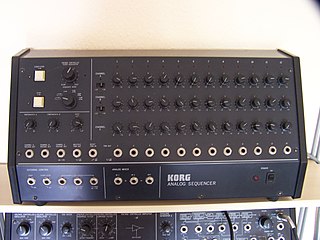Related Research Articles
Electronic music broadly is a group of music genres that employ electronic musical instruments, circuitry-based music technology and software, or general-purpose electronics in its creation. It includes both music made using electronic and electromechanical means. Pure electronic instruments depended entirely on circuitry-based sound generation, for instance using devices such as an electronic oscillator, theremin, or synthesizer. Electromechanical instruments can have mechanical parts such as strings, hammers, and electric elements including magnetic pickups, power amplifiers and loudspeakers. Such electromechanical devices include the telharmonium, Hammond organ, electric piano and electric guitar.

An electronic musical instrument or electrophone is a musical instrument that produces sound using electronic circuitry. Such an instrument sounds by outputting an electrical, electronic or digital audio signal that ultimately is plugged into a power amplifier which drives a loudspeaker, creating the sound heard by the performer and listener.

Robert Arthur Moog was an American engineer and electronic music pioneer. He was the founder of the synthesizer manufacturer Moog Music and the inventor of the first commercial synthesizer, the Moog synthesizer, which debuted in 1964. In 1970, Moog released a more portable model, the Minimoog, described as the most famous and influential synthesizer in history. Among Moog's honors are a Technical Grammy Award, received in 2002, and an induction into the National Inventors Hall of Fame.

The theremin is an electronic musical instrument controlled without physical contact by the performer. It is named after its inventor, Leon Theremin, who patented the device in 1928.

Digital music technology encompasses digital instruments, computers, electronic effects units, software, or digital audio equipment by a performer, composer, sound engineer, DJ, or record producer to produce, perform or record music. The term refers to electronic devices, instruments, computer hardware, and software used in performance, playback, recording, composition, mixing, analysis, and editing of music.
A music sequencer is a device or application software that can record, edit, or play back music, by handling note and performance information in several forms, typically CV/Gate, MIDI, or Open Sound Control, and possibly audio and automation data for digital audio workstations (DAWs) and plug-ins.

Raymond Scott was an American composer, band leader, pianist, record producer, and inventor of electronic instruments.

An analog synthesizer is a synthesizer that uses analog circuits and analog signals to generate sound electronically.

The Minimoog is an analog synthesizer first manufactured by Moog Music between 1970 and 1981. Designed as a more affordable, portable version of the modular Moog synthesizer, it was the first synthesizer sold in retail stores. It was first popular with progressive rock and jazz musicians and found wide use in disco, pop, rock and electronic music.

ARP Instruments, Inc. was a Lexington, Massachusetts manufacturer of electronic musical instruments, founded by Alan Robert Pearlman in 1969. It created a popular and commercially successful range of synthesizers throughout the 1970s before declaring bankruptcy in 1981. The company earned a reputation for producing excellent sounding, innovative instruments and was granted several patents for the technology it developed.
Sequential is an American synthesizer company founded in 1974 as Sequential Circuits by Dave Smith. In 1978, Sequential released the Prophet-5, the first programmable polyphonic synthesizer, which was widely used in the music industry. In the 1980s, Sequential was important in the development of MIDI, a technical standard for synchronizing electronic instruments.

Moog Music Inc. is an American synthesizer company based in Asheville, North Carolina. It was founded in 1953 as R. A. Moog Co. by Robert Moog and his father and was renamed Moog Music in 1972. Its early instruments included the Moog synthesizer, followed by the Minimoog in 1970, both of which were highly influential electronic instruments.

The Moog synthesizer is a modular synthesizer invented by the American engineer Robert Moog in 1964. Moog's company, R. A. Moog Co., produced numerous models from 1965 to 1981, and again from 2014. It was the first commercial synthesizer and established the analog synthesizer concept.

The Moog model 2090 Micromoog is a monophonic analog synthesizer produced by Moog Music from 1975 to 1979.

The Minimoog Voyager or Voyager is a monophonic analog synthesizer, designed by Robert Moog and released in 2002 by Moog Music. Five years earlier in 1997, the Minimoog Voyager Electric Blue was first produced by Moog Music. The Voyager was modeled after the classic Minimoog synthesizer that was popular in the 1970s, and is meant to be a successor to that instrument.

A synthesizer is an electronic musical instrument that generates audio signals. Synthesizers typically create sounds by generating waveforms through methods including subtractive synthesis, additive synthesis and frequency modulation synthesis. These sounds may be altered by components such as filters, which cut or boost frequencies; envelopes, which control articulation, or how notes begin and end; and low-frequency oscillators, which modulate parameters such as pitch, volume, or filter characteristics affecting timbre. Synthesizers are typically played with keyboards or controlled by sequencers, software or other instruments and may be synchronized to other equipment via MIDI.

An analog sequencer is a music sequencer constructed from analog (analogue) electronics, invented in the first half of the 20th century.

Herbert Arnold "Herb" Deutsch was an American composer, inventor, and educator. Until his death in 2022, he was professor emeritus of electronic music and composition at Hofstra University. He was best known for co-inventing the Moog synthesizer with Bob Moog in 1964.
The timeline of music technology provides the major dates in the history of electric music technologies inventions from the 1800s to the early 1900s and electronic and digital music technologies from 1874 and electric music technologies to the 2010s.
References
- ↑ "Raymond Scott: Artifacts from the Archives" (PDF). RaymondScott.net. Retrieved March 21, 2024.
- ↑ Crab, Simon (2013-09-22). "The 'Clavivox' Raymond Scott, USA, 1952". 120 Years of Electronic Music. Retrieved 23 December 2017.
- ↑ Glinsky, Albert (2022). Switched On: Bob Moog and the Synthesizer Revolution. New York City, New York, US: Oxford University Press. pp. 32–33. ISBN 9780197642078.
- ↑ Rhea, Tom (February 1981). "Electronic Perspectives - Raymond Scott's Clavivox & Electronium". Keyboard. Retrieved November 16, 2023.
- ↑ Chusid, Irwin; Winner, Jeff (December 2001). "Circle Machines and Sequencers: The Untold History of Raymond Scott's Electronica". Electronic Magazine. Retrieved November 16, 2023.